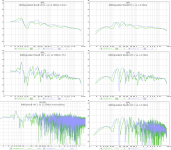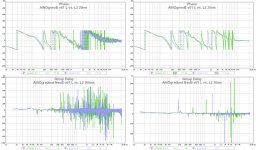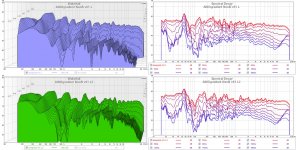Your use of low quality measurement equipment not designed for the task is appalling. Do you know anything other than sensitivity and response of your non traceable uncertified microphones? If you repeat with they are calibrated, I will laugh, as they would be considered inadmissable in court for even SPL measurements. I at least understand the limitations of the UMIK-1's I own and what calibration means having run a NIST traceable cal lab on hundreds of equipment of all shape and form.
This attack is unfounded. Just because a court requires a calibration trace is no support for not using "typical microphones" in tests like this. The calibration is almost exclusively to calibrate sensitivity, which is irrelevant in these discussions. Unless the microphone is actually broken its frequency response will be sufficient to study any and all issues being discussed here. I find this attack to be precisely what you are claiming about Markus (who is also quite often guilty of obscuring the issues to win the argument.)
Instead we should talk about why barleywater is wrong and why PEQs work for room equalization (or why not).
I'd appreciate that.
Somehow all of the DIY Audio E-mails are getting "junked". So I have been out of the loop.
Are we talking about room EQ above Schroeder, or below, or both? The answers are all quite different.why PEQs work for room equalization (or why not).
Greebster, you're digging a pretty deep hole here.
One of my mics was calibrated by Herb Singleton of Cross Spectrum Labs and another one by a German vendor. I compare them from time to time just to make sure I'm not fooling myself. It's your claim that I'm using "measurement equipment not designed for the task" that is "appalling".
The point that is all they tested, frequency response and nothing else. Not that the quality of how they tested is at question if you understand the limitations. Would be saying mine and your elcheapo's are as good as true high end instrumentation mic's that cost thousands. I would never draw that conclusion, nor should you.
My first mic was something I made 28years ago and used a panasonic electret element with a phantom ps. It worked very well, but reference was missing. This did not stop me from using it, quite the contrary, proved quite useful especially in the low mids to near 10k, flat on axis, despite being "Omni". Wasn't the first or the last mic I made, some including ribbon mics as I was just as interested in all this as you are today. Difference was digital wasn't there yet and even when it did show up on scene cost a fortune. So old school analog ruled supreme. When understanding test parameters you also accept the limitations of the test. I do not know of any place on the planet that does these types of tests for under a grand, you supply the lab grade mic.
Here is a brand I am very familar with Microphones and preamplifiers - Brüel & Kjær
Are we talking about room EQ above Schroeder, or below, or both? The answers are all quite different.
Above AND below.
I've made my point already somewhere in this thread, first page or so.
This is from Dirac link (Above)
"Multiple measurements
Dirac Live uses several measurement positions (9 typically) in the listening room.This way, it is possible to find consistent acoustic problems. Only these should be corrected.
This is common and sane procedure. Still I am stupid enough to not understand how time-domain correction is possible in signal level, but I guess it is - and I relly would like to see measurements before/after.
I use REW and I like to look at amplitude response and short/long decay in many ways and with different analysis parameters. I have been doing this for half a year now weekly, total hundreds of hours - and I am sill puzzled with many things! It is very difficult to get "touch" of these things. Automatic correction like Dirac is very useful, if it really works.
This topic is about PEQ and as a minidsp user with 4-way speakers, I can do it for each "way" L/R separately and even for the full signal for L/R. The problem lies with measurements in a small room! Even some 10-25cm (4-10") move of the microphone makes wiggles to mirror images! As stated earlier and in many other threads, below schroeder this is a little easier. One general rule is to avoid high Q (sharp) corrections because they are too space-spesific. Half-octave accuracy is practical maximum, but there are some exceptions.
This morning I had a measurement session with AINOs, about 4 hours of hardcore tuning and parameter setting. Result will be shown later here, they are in my laptop now.
"Multiple measurements
Dirac Live uses several measurement positions (9 typically) in the listening room.This way, it is possible to find consistent acoustic problems. Only these should be corrected.
An externally hosted image should be here but it was not working when we last tested it.
In terms of the impulse response, this means the direct wave and very early reflections. Generally, at higher frequencies there is less consistent time-domain behavior. Dirac Live automatically finds consistent problems in a frequency-dependent way and corrects for them. After finding consistent time-domain behavior, there may still be some late reverberation in the room that causes a gentle coloration. This is corrected in the frequency domain with just the right resolution.Impulse response correction
The impulse response of a loudspeaker affects clarity, tightness and all spatial aspects of the sound, such as location and distinctness. Dirac Live is unique in actually correcting the impulse response in a large listening area, not just a single point. By focusing on consistent problems across the measurement positions, and correcting only these, a faster decay time is achieved. Typically, the power ratio between the direct wave and the tail is improved by 6 dB or more, representing a vastly tighter sound."
---The impulse response of a loudspeaker affects clarity, tightness and all spatial aspects of the sound, such as location and distinctness. Dirac Live is unique in actually correcting the impulse response in a large listening area, not just a single point. By focusing on consistent problems across the measurement positions, and correcting only these, a faster decay time is achieved. Typically, the power ratio between the direct wave and the tail is improved by 6 dB or more, representing a vastly tighter sound."
This is common and sane procedure. Still I am stupid enough to not understand how time-domain correction is possible in signal level, but I guess it is - and I relly would like to see measurements before/after.
I use REW and I like to look at amplitude response and short/long decay in many ways and with different analysis parameters. I have been doing this for half a year now weekly, total hundreds of hours - and I am sill puzzled with many things! It is very difficult to get "touch" of these things. Automatic correction like Dirac is very useful, if it really works.
This topic is about PEQ and as a minidsp user with 4-way speakers, I can do it for each "way" L/R separately and even for the full signal for L/R. The problem lies with measurements in a small room! Even some 10-25cm (4-10") move of the microphone makes wiggles to mirror images! As stated earlier and in many other threads, below schroeder this is a little easier. One general rule is to avoid high Q (sharp) corrections because they are too space-spesific. Half-octave accuracy is practical maximum, but there are some exceptions.
This morning I had a measurement session with AINOs, about 4 hours of hardcore tuning and parameter setting. Result will be shown later here, they are in my laptop now.
Still I am stupid enough to not understand how time-domain correction is possible in signal level
Good read: http://www.dirac.se/media/12044/on_room_correction.pdf
Another fine example of blinders on is like when Columbia burned up and all the NASA engineering geniuses said that piece of foam was of no concern. Standing in the back was one engineer that stood out and said you are all wrong.
That was Richard Feynman, a physicist, like me, and not an engineer. And he was at the front of the room, not the back. Anecdotes are always better when they are actually said correctly.
Above AND below.
Anyone who believes that the solutions or approaches above and below are not completely different does not understand the problem.
he impulse response of a loudspeaker affects clarity, tightness and all spatial aspects of the sound, such as location and distinctness. Dirac Live is unique in actually correcting the impulse response in a large listening area, not just a single point.
This is physically impossible. One can ideally correct an impulse response only at a single point. One can optimize the response over an area by averaging several measurements, but then all time information is lost. EQ should not be done on a speaker in a room for anything but the direct field. For the direct field spatial averaging is not desirable, but polar response control in the loudspeaker is. But this is best done outside of the room. Where this cannot be done outside of the room is at LFs below Schroeder. There only steady state sound is meaningful and must be done in-situ.
That was Richard Feynman, a physicist, like me, and not an engineer. And he was at the front of the room, not the back. Anecdotes are always better when they are actually said correctly.
In the original video clip of the scene as seen on PBS showed him in the back of a dimly lit room at least is my recollection of the PBS Frontline documentary on the subject. The gist is this mattered not if he was a Ph.D or an engineer and it doesn't matter if he was in the front, middle or back of the room.
I laugh at the difference between engineers and Ph.D's, especially when they bicker!
Have been meaning to ask... You don't have any Pink Floyd in your collection?
(stereo bass reference)
The point that is all they tested, frequency response and nothing else. Not that the quality of how they tested is at question if you understand the limitations. Would be saying mine and your elcheapo's are as good as true high end instrumentation mic's that cost thousands. I would never draw that conclusion, nor should you.
Nobody claimed that "elcheapo's" would be of higher quality than a B&K mic. They just need to be good enough. Our calibrated mics are good enough for the task at hand, aren't they?
This is what a sample calibration report from Cross Spectrum Labs looks like: http://www.cross-spectrum.com/cslmics/1280053_mic_report.pdf
One gets narrowband and 1/3 octave band calibration files for 3 different angles of incident.
Last edited:
I laugh at the difference between engineers and Ph.D's, especially when they bicker!is like watching the Big Bang Theory aye Sheldon?
Have been meaning to ask... You don't have any Pink Floyd in your collection?
(stereo bass reference)
Except that Sheldon is an actor made to look like a pompous azz. No real physicist that I know acts like that.
If you are asking me, yes, I do have Pink Floyd. Its not at the top of my playlist but I have a couple of their CDs. I even have Jimmy Hendrix and Captain Beefheart.
So what numbers do you propose?
Markus, when you listen from listening position where you made the 20cm x 20cm x 20cm measurement set, what perceptual changes to you hear when you move your head about in same region?
In my experience, listening to single speaker with broadband signals while moving head about and seated at listening position results in little if any change in timbrel qualities of speaker sound, and I find that these head movements allow accurate determination of speaker location in terms of direction, distance and height. With stereo pair of speakers, mono broadband signal source, and listening position equidistant to both speakers, perception is of virtual source positioned directly between speakers, appearing at height of tweeters, and located at some distance behind vertical plane containing speakers. Distance behind speakers correlates in direct proportion to listening distance in front of vertical plane. The further back listening position is, the further behind vertical plane the virtual source location becomes. With listening position in vertical plane, and using omnidirectional speaker, or aiming speakers with directive characteristic at head, headphone effect is perceived with sound appearing to come from within head. With head in vertical plane of speakers, timing cues and intensity cues are highly correlated. Small movement of head in vertical plane towards one speaker from center between speakers results in perceived sound remaining in head. As head moves closer to one speaker, sound leaves head, and more distant speaker effectively disappears. Effectively disappears is tempered by change of perception when the more distant speaker is suddenly muted; Intensity of perceived sound dropping is primary change. Sense of apparent source size is diminished, yet seems more focused. With both speakers the most critical information gained from vertical plane listening positions is ratio of speaker intensities when sound perception starts shifting from out of head.
With my Linkwitz Pluto type speakers, sound is highly omnidirectional to about 2kHz, and above this frequency directivity of 2" tweeter becomes dominant. Perceptual cues for direction have increasing dominance with increasing frequency. Long dimension of my listening space is about 8m. With speaker plane set across midpoint at about 4m, and pointed at front wall (which is about 85% glass windows), and listening with head directly between speakers with broadband signal, full spectrum of sound is perceived as coming from outside of house. Bass response is tight, but too high. Proximity to speaker, and head location in primary room mode account for this, and are readily equalized. For stereo recordings, (symphonic music in particular) image is deep and wide with front of stage starting beyond window, extending well into front yard; width of stage extends beyond side walls of room. Short transient broadband bursts pass through doorway to dining room, and through further doorway from dining room into kitchen; reverberant echo from dining room and from kitchen are easily heard, and measured.
All measurement are based on capture of finite data. All generated broadband transients, regardless of weather starting with step response of IIR type filter or windowed start of FIR type filter. IIR starts with step, all frequencies start at zero amplitude and identical phase. With FIR generated impulse, convenient zero time is chosen as point where all frequencies are in phase and maximum amplitude, start of window is zero amplitude with phase of all frequencies referenced to signal peak location.
Brick wall high pass filters formed by either FIR or IIR techniques results in considerable ringing that is proportionate to filter order for IIR type, and tap count for FIR type. Both filters produce a popping sound, but pre peak ringing of FIR is also heard . Post peak ringing is highly masked for both filter types. In case of IIR type most of post ringing perceptual stream is assigned to onset event, but also carries what is sometimes described as "phased" charachter. With FIR type, pre ringing is assigned perceptual stream, and peak event becomes a second separate perceptual stream.
If a high pass filter is set below bandwidth of source signals no ringing is heard. When located in pass band, filters behave as crossover filters. In all cases of IIR based crossover, except for case of 1st order crossover (of little practical use), summation as all pass filter results in phase shifts and/or frequency response changes. FIR crossover sums to Dirac function, with flat phase response and flat frequency response.
Applied to real speaker, FIR based crossover can be guaranteed to have no audible ringing. If driver spacing is <1/4 wavelength of crossover frequency, no ringing is heard off axis, or from reflections from off axis.
My FIR implementation of 1kHz crossover for Pluto type speaker meets this criteria, even with effective crossover slope of >200dB/octave.
In short, PEQ may be very effectively used for correcting timbrel imbalance do to speaker, and speaker room interaction at listening position. Likewise, FIR based EQ derived from direct measurement at listening position may be very effectively used for correcting timbrel imbalance. "may be" here is qualified by use of filters for reducing peaks. Deep nulls do to speaker/room/listening position can only be addressed by physical changes in these parameter. If deep null exists in sparse room mode region that occurs at frequencies common to music content, it may be objectionable, even though common to all listening experiences in reflective spaces. Shifts of speaker and listening position for given room effectively fix this.
The less well damped a room is, the narrower peaks become, and the higher in amplitude.
My room decays to complete ambiance in less than 300ms, despite highly reflective walls with lots of brick, glass, and 3/4" wood paneling. Room is well furnished, with wall to wall wool carpet and carpet padding, acoustic tile ceiling, and ceiling broken up by three wooden beams:
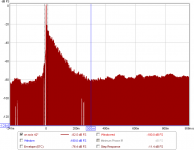
Zooming of time axis reveals pre ringing of FIR high pass filter controlling bass cutoff used. Pre ringing peaks at about -40dB <1ms pre peak. No ringing is heard with music source:
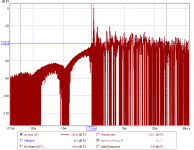
Anyone who believes that the solutions or approaches above and below are not completely different does not understand the problem.
I understand the problem (or, at least, I hope I do), that's why I want to talk about the benefits and drawbacks of PEQs in both frequency ranges. Separately.
I read the dirac white paper again (shortly) and I guess that FIR filters are able to change the phase (time domain) and amplitude. IIR can only change amplitude - correct?
To make things simple here I show only 2 measurements of the same spaker in same locations, only microphone moved 50cm in z-plane (distance) in my living room. The EDT is around 0.3ms and T30 is 0.3 - 0.6ms. The speaker was some 20¤ turned, that is why response is declining so much. These measurement represent the "best" response that I achieved after many hours of minidsp tuning. Room has not any acoustic treatment and speakers are 80cm from Windows on the front wall. Side walls are 2m away. The speaker has monopole bass xo130Hz, dipole mids and tweeters.
Please look at these and notice the difference of "peaks" and "dips" frequency and magnitude. Phase and GD changes are very sharp because they are due to reflections, not caused by the speaker itself.
These are just 2 measurement sweeps analyzed with REW. Then, take 6-10 more measurements and try to make sense of that! I get a headache from just these 2!
Basics - room treatment is far more WISE than electric EQ of any sort - but not much easier though.
To make things simple here I show only 2 measurements of the same spaker in same locations, only microphone moved 50cm in z-plane (distance) in my living room. The EDT is around 0.3ms and T30 is 0.3 - 0.6ms. The speaker was some 20¤ turned, that is why response is declining so much. These measurement represent the "best" response that I achieved after many hours of minidsp tuning. Room has not any acoustic treatment and speakers are 80cm from Windows on the front wall. Side walls are 2m away. The speaker has monopole bass xo130Hz, dipole mids and tweeters.
Please look at these and notice the difference of "peaks" and "dips" frequency and magnitude. Phase and GD changes are very sharp because they are due to reflections, not caused by the speaker itself.
These are just 2 measurement sweeps analyzed with REW. Then, take 6-10 more measurements and try to make sense of that! I get a headache from just these 2!
Basics - room treatment is far more WISE than electric EQ of any sort - but not much easier though.
Attachments
Last edited:
Here is an acoustic measurement comparison between Audessey and Acourate room corrections. These are not my results, but from someone I was assisting on the REW forum: http://www.hometheatershack.com/forums/rew-forum/73135-measuring-results-convolution.html#post683766
Note the impulse response. Almost identical to the results I achieved on my system and posted on this thread a few pages back.
With respect to "room correction", one needs to understand first that the acoustic analysis software used to measure the "room" requires frequency dependent windowing (FDW). Otherwise, with a fixed window size, one can only measure one point in time and therefore can only correct one point (or position) in time.
This is a good explanation of FDW and it's applicability to "room correction": DRC: Digital Room Correction
Another good read on FDW and how it applies to room correction is JJ Johnstons: http://www.aes.org/sections/pnw/ppt/jj/room_correction.ppt (Note PowerPoint slides)
Note the impulse response. Almost identical to the results I achieved on my system and posted on this thread a few pages back.
With respect to "room correction", one needs to understand first that the acoustic analysis software used to measure the "room" requires frequency dependent windowing (FDW). Otherwise, with a fixed window size, one can only measure one point in time and therefore can only correct one point (or position) in time.
This is a good explanation of FDW and it's applicability to "room correction": DRC: Digital Room Correction
Another good read on FDW and how it applies to room correction is JJ Johnstons: http://www.aes.org/sections/pnw/ppt/jj/room_correction.ppt (Note PowerPoint slides)
I understand the problem (or, at least, I hope I do), that's why I want to talk about the benefits and drawbacks of PEQs in both frequency ranges. Separately.
That's exactly what has to happen. You have to be clear on what range you are talking about because they are different.
- Status
- This old topic is closed. If you want to reopen this topic, contact a moderator using the "Report Post" button.
- Home
- General Interest
- Room Acoustics & Mods
- Room Correction with PEQ

